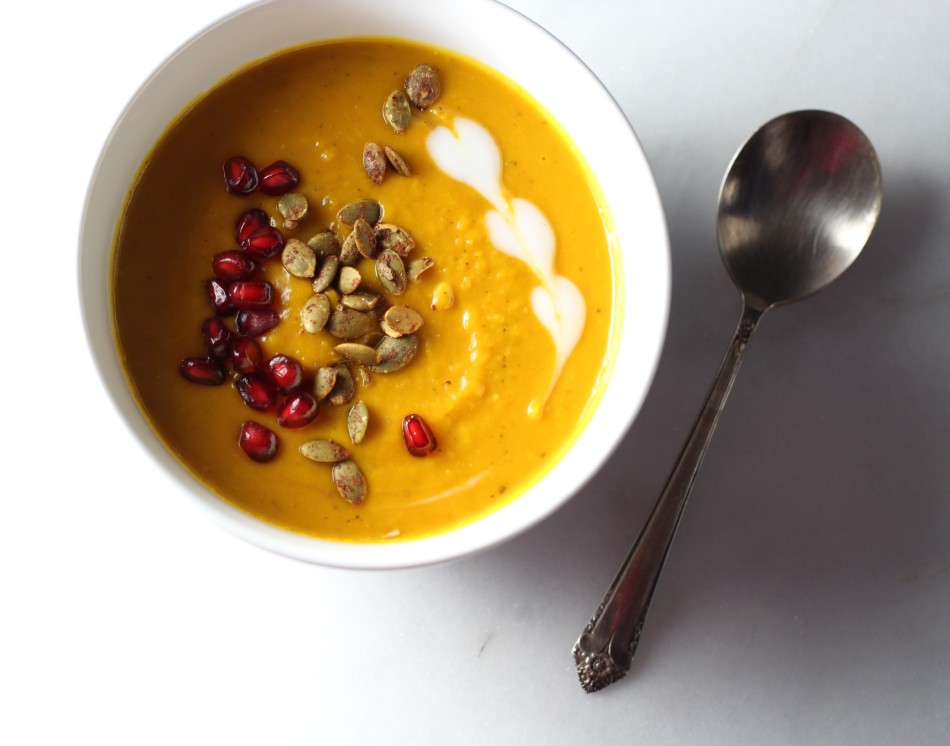
It’s November! Over the weekend, I have been a busy bee compiling my notes and jotting down my sweet and savory recipe ideas for Thanksgiving and I can’t wait to share them with you! Oh, the decisions … the best kind in life. This is my favorite time of the year to push my hectic life aside to enjoy the moments … loved ones, traditions, reflecting on the good things in life … and with that good food.
I’m excited! Soup to kick off Thanksgiving eats and because it was windy and rainy yesterday (the practical side is never far).
So, how was Halloween? Hope it was fun (or super scary if that’s your thing) and only filled with ache-free treats and good times. We went to a classmate’s afternoon party then came home to pack up dinner and head over to an indoor trampoline gym. Imagine a huge two-story high open warehouse full of trampolines, 50-foot wide trampolines. Needless to say, the place knocked us out and helped burn off some of the chocolates we’ve been eating all day.
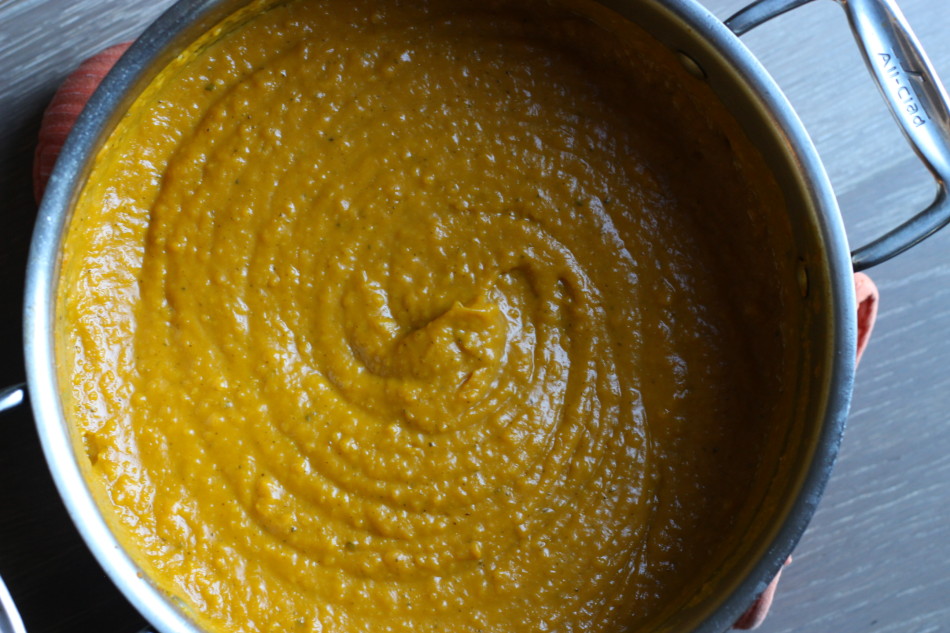
This soup was the perfect antidote to our sweet bingeing.
My first taste of kabocha was 15 years ago at my friend Lolita’s house. I walked into an aroma of something that resembled butternut and maple – whatever it was, it was always delicious and I was eager for our lunch together. She made us a lentil beef stew and served it with kabocha squash. She served the kabocha quartered; the first thing that struck me was it’s gorgeous deep orange color and then how sweet and creamy it was. It never occurred to me that this nubby looking thing had so much flavor. It tastes like a cross between butternut and sweet potato. When she began to eat the peel, I did too! Who was I to argue? Had it not been for Lolita, this squash variety would never end up in my kitchen (hey Lolita!). And yes, we now always eat the peel.
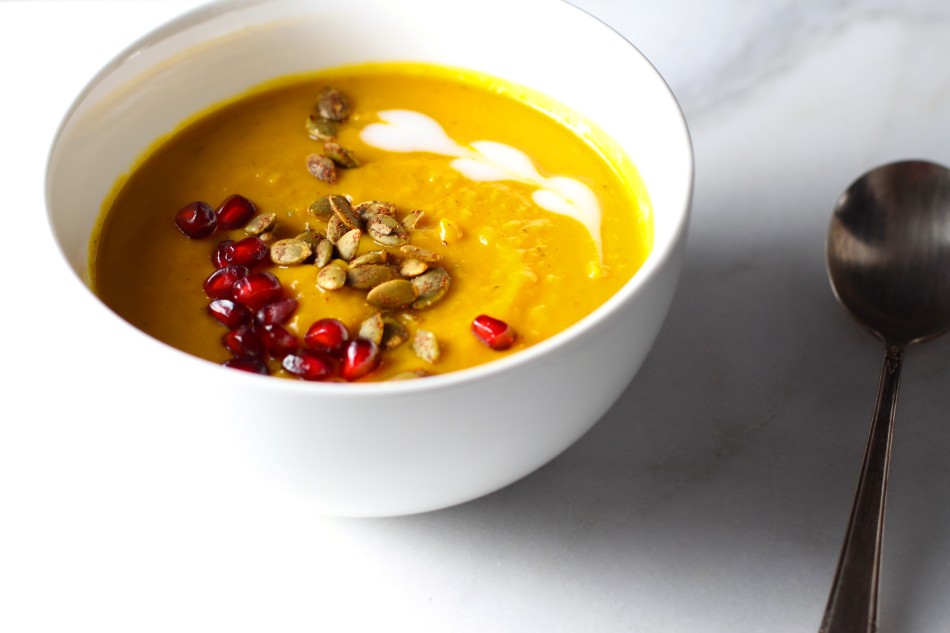
If you have been passing cute squashes by while reaching for the ever-popular butternut please stop and take another look. These nutritionally packed squash are worth taking home.
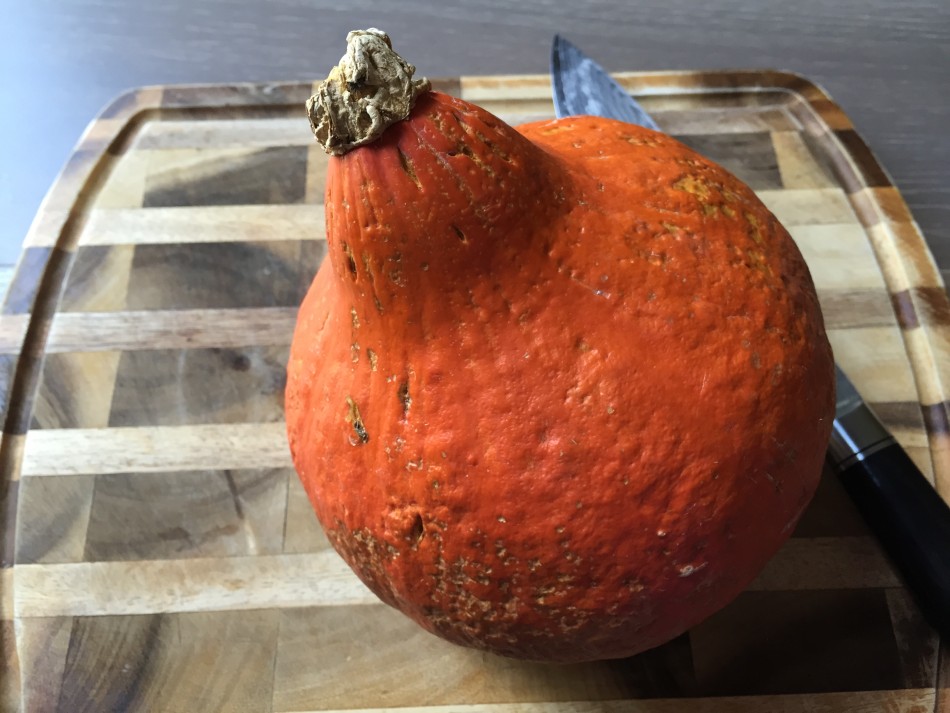
Pick me! Pick me!
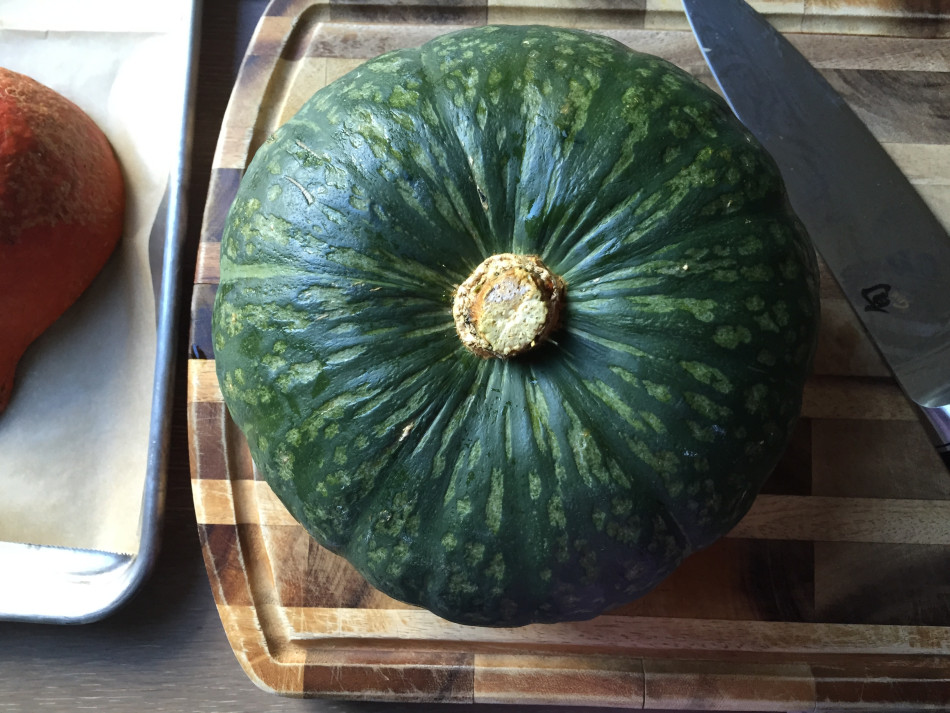
And pretty easy to prepare for roasting … make sure to use your biggest, sturdy knife for this. For the kabocha: push the knife only a third of the way, you will be tempting to just jab the whole knife in, but it will get stuck and won’t allow you to get a clean cut. Instead, gently and in a sawing motion, ease the knife in until it cuts through 3/4 of the way. The kuri squash cuts easier than kabocha and is pretty straight forward.
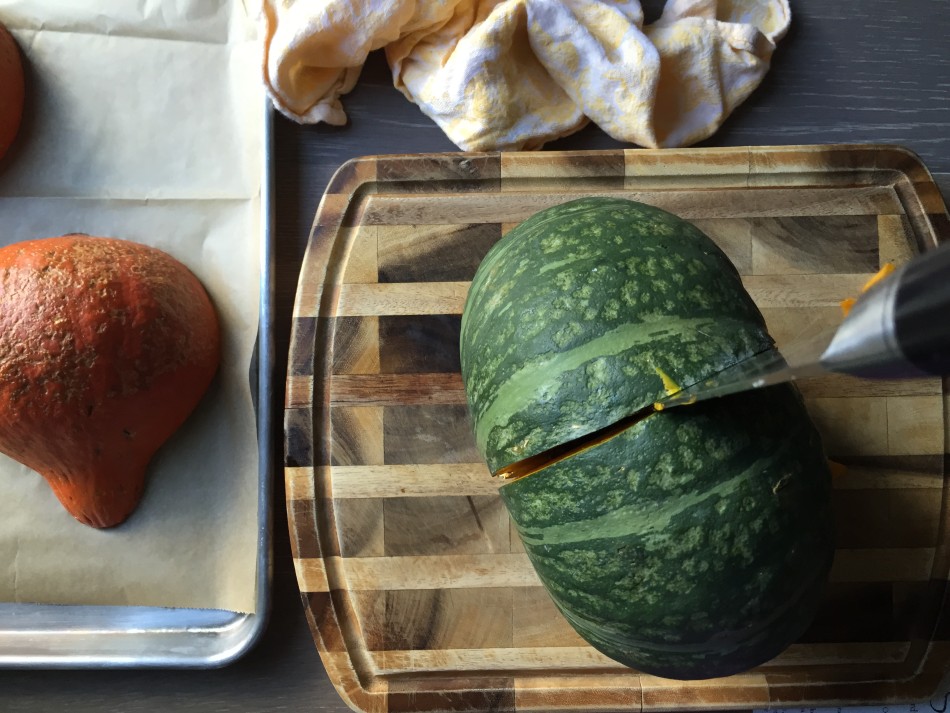

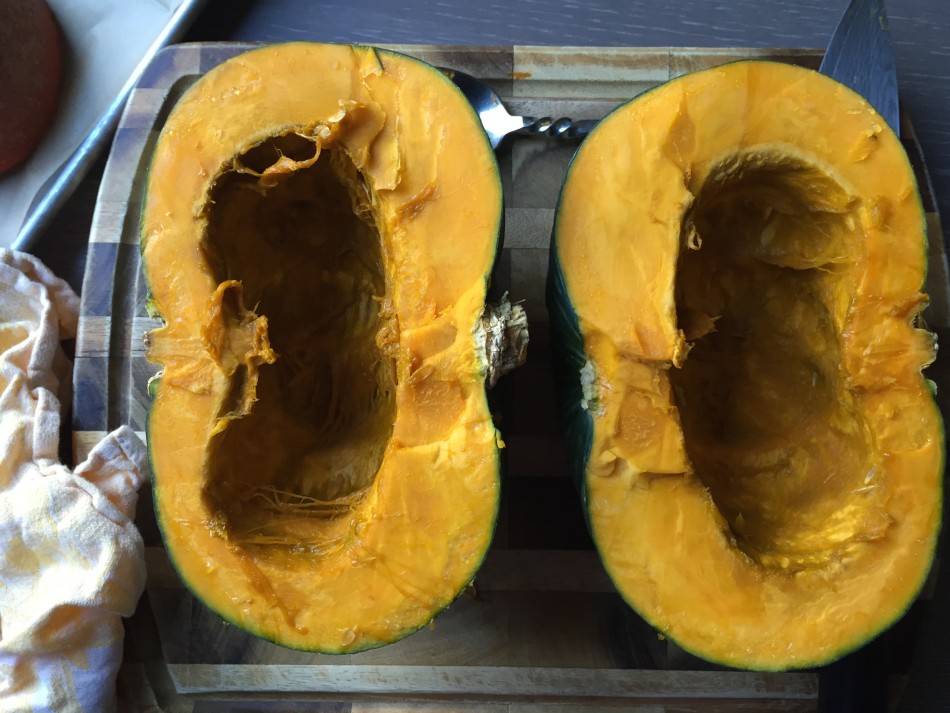
That’s it!
By the way, how cool is it when you taste something new and surprisingly good and think Oh wow this is good? So cool right.
(Red) Kuri squash, my other discovery 6-7 years ago was at a restaurant in Santa Monica that served Kuri squash soup with pear and candied walnuts on top. After that, my new squash of the moment was kuri squash. It kind of looks like a bright orange gourd with smooth skin. And when facing down … look like hot air balloons. Do you see that?!
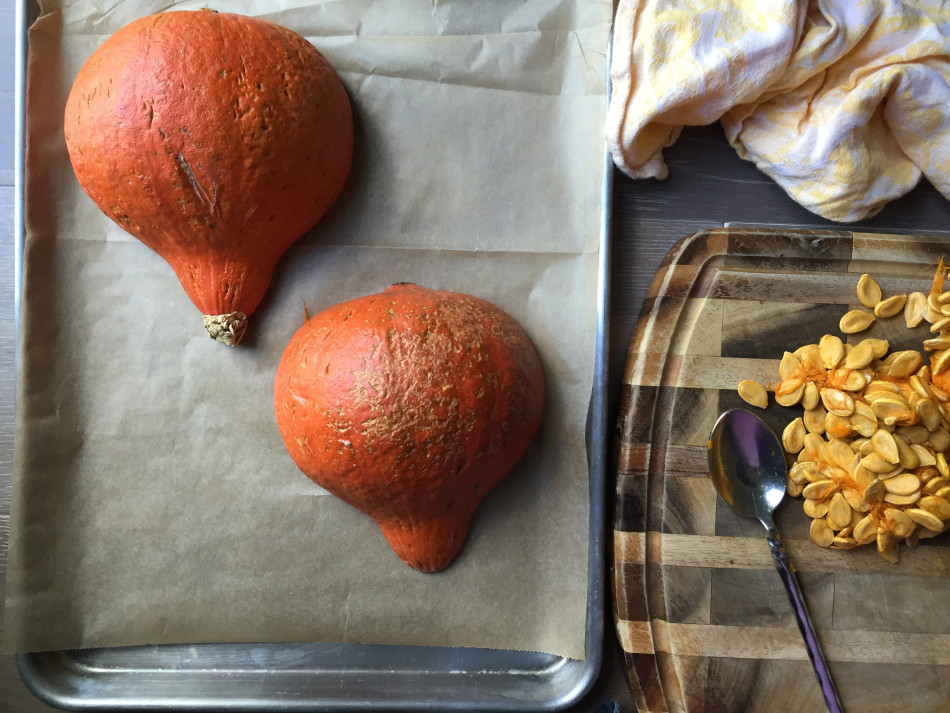
Not as sweet as kabocha, but still has some sweetness like acorn squash along with a nutty, earthy taste similar to chestnuts.
This is warm and comforting and the perfect thing to have simmer on your stove after a long chilly day. Just the color will brighten up any one’s day.
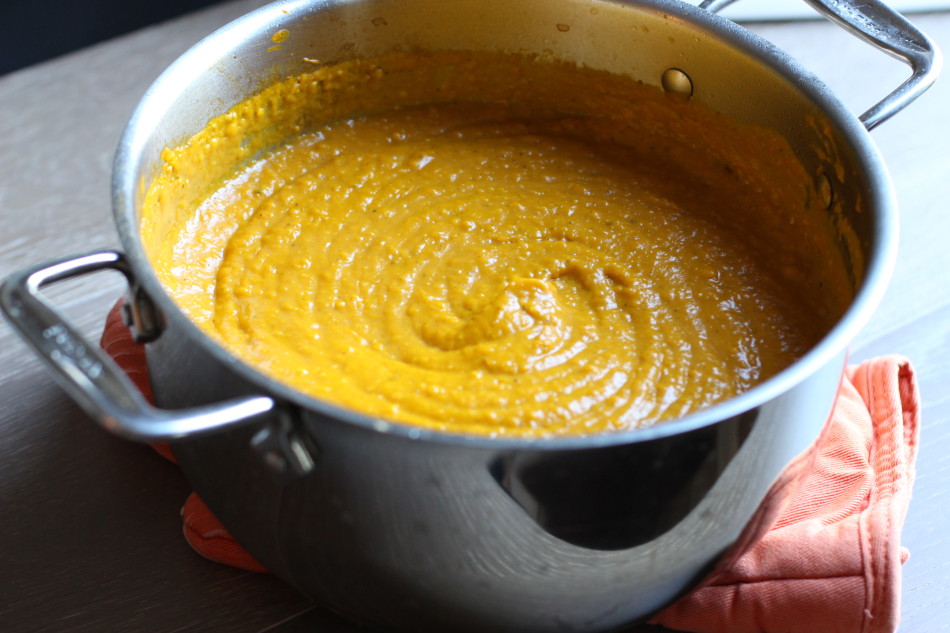
You are probably wondering, why the young coconut meat? It’s not “tropical” tasting, rather more mild (see notes for more) and embraces the squash flavors with subtlety yet at the same time gives the soup depth and a good “meatiness”. Cider vinegar gives the soup a little nudge of tang, just enough to brighten up the nutty flavors without being overpoweringly acidic.
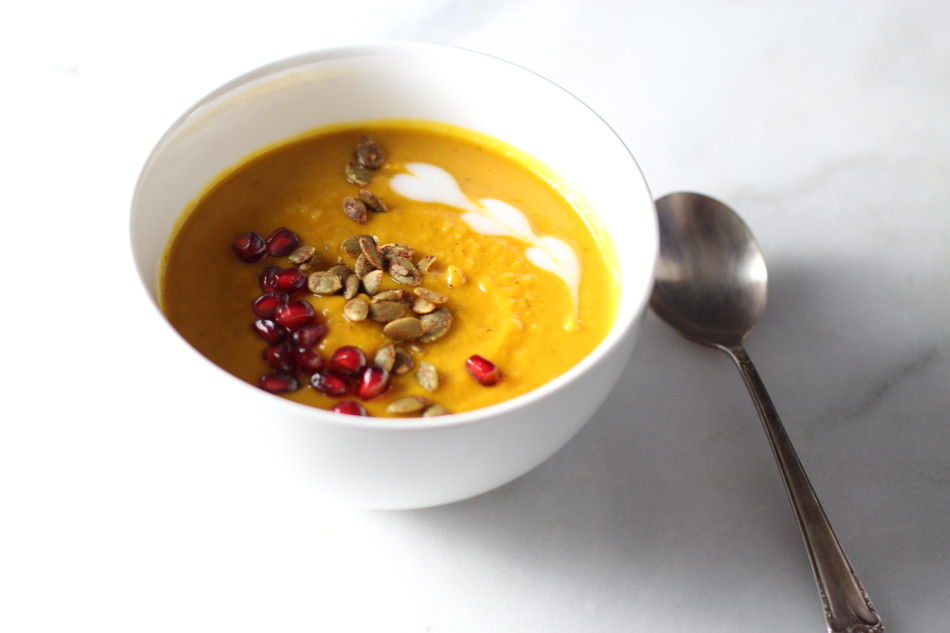
A satisfying soup that I must say is perfect for any time in the season as well as Thanksgiving, lunch or dinner. I think I will be serving it in little shot glasses as an appetizer so as not to fill up my guests too much before the meal. I still want them plenty hungry.
Okay … now I need to get back in the kitchen and stop jabbering. Cooking up a few savory dishes (more recipe testing!) for Thanksgiving along with dinner … before I pick the boys up from school then onto their after-school regimen, tutoring for my high schooler, and teeth cleanings for all three … dinner, homework, reading time.
Which reminds me: I need more coffee. And maybe some waffles.
Happy Tuesday!
xx
- 2 medium
onions, diced - ½ kabocha squash, spray and rinse well, seeds removed (preferably organic)
- 1 red
red kuri squash, halved, seeds removed (preferably organic) - 16 ounces (454 g) raw young Thai coconut meat (sold in health food stores freezer section)
- 3 teaspoons kosher salt
- 3 teaspoons ground ginger
- 1 teaspoon grated or ground nutmeg
- 1 tablespoon apple cider vinegar or rice wine vinegar
- 4 cups coconut milk, unsweetened (not canned)
- 4 cups
low sodium vegetable (or any) stock (I use homemade or Imagine Organic brand) - 3-4 tablespoons
grape seed or coconut oil - For garnish:
- cayenne spiced pumpkin seeds (I personally love
superseedz somewhat spicy flavor) - pomegranate seeds
- unsweetened coconut yogurt
- Note: Allow 1 hour and 30 minutes for preheating, roasting and cooling of squashes before adding to
soup . Please read additional notes below. - Preheat oven to 400 degrees F (204 Celsius).
- Place seeded kabocha and
kuri squash with cut side down, onto a parchment lined baking sheet. Whenoven is at temperature, roast for 55 minutes. Let cool for 10 minutes, or until cool to the touch and remove thekuri squash peel. The kabocha squash peel is edible and has a nice nutty flavor to it. - Roughly mash the squash and add to the soup pot. Meanwhile, set a large soup pot on
medium high heat. When heated, add oil and onions. Stir to coat well. Add both squashes, and coconut meat, stir again. Then add kosher salt, ginger, nutmeg, and apple cider vinegar. Stir again (lots of stirring to combine flavors and prevent any burning on the bottom before the addition of liquids). Add coconutmilk, and vegetable broth. - Once it comes to a boil reduce heat to medium and simmer for 20 minutes.
- Optional: garnish with pumpkin seeds, pomegranate
seeds and coconut yogurt. If you like a little heat, try a splash of chili oil (my favorite). Other tasty options: fresh slices of pear (or apple) with candied walnuts or diced persimmon and toasted pine nuts. - Some Additional Notes:
- Organic squash is readily available these days and strongly suggest using it here since we are adding the peel into the soup. Pesticides binds to produce skin very well, even a good amount of washing.
I don’t remove the peel of the kabocha since it is edible and packed with additional fiber and beta-carotene, so adding the skin gives you two times the nutrients! Trust (please!) that it will not taste strange or like dirt by leaving the peel on.Thekuri squash peel is also edible but somewhat bitter to me so I remove it. Give it a taste after it has cooled as see if you like it. If you choose to add it to the soup, add 1-2 cups of extra broth and coconut milk (equal parts) to maintain a soup-like consistency.- For removing the peel: if you find the peel doesn’t separate from the squash use a spoon to scrape it off.
- If you are using a high sodium broth, hold off on adding the salt and adjust accordingly.
- I use vegetable stock to bring out the rich autumn flavors of the squash in this soup, and the coconut milk to keep it light in taste. Solely using vegetable stock weighs it down in terms of flavor and feels like heavy. Only using coconut milk brings
on a whole other type of soup; one that tastes flat without the inclusion of fresh ginger, lemongrass, and chili for more of aThai inspired soup. Using both balances “light and creamy” with “rich and hearty.” - Coconut meat is a very mild tasting coconut, sold frozen - due to their live enzymes - and found in most health food stores. Make sure the package says “pure young Thai coconut meat”. Coconut oil and coconut meat
does not have a strong coconut flavor like canned coconut does, which is manmade. Using canned coconut will bring on a moreThai inspired flavor and strong notes of coconut, whereas, young coconut doesn’t compete with the squashes in this recipe. - The frozen, packaged, coconut meat is the same as what is along the inside shell of the white “conehead” shaped coconut wrapped in plastic wrap - minus the water- sold in the refrigerated section. I prefer to buy just the meat from the freezer section because a) it won’t spoil if I don’t end up using it right away b) no coconut shells remnants to worry about c) convenience d) without coconut water, which is high in sugar. It is a higher-priced item, like most specialty
foods are, but feel it’s worth the splurge considering it’s high lauric acid (a saturated fat that is LOW in cholesterol despite what they taught medics in the ’70’s), ananti fungal , anti bacterial and high fiber food.
Don't miss a recipe! Subscribe here.


Comments